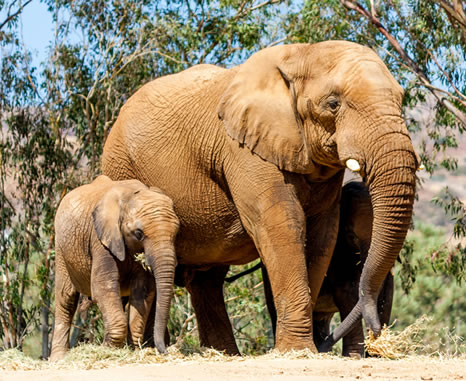The practice of keeping animals in captivity and forcing them to perform tricks or other unnatural activities has been a part of human tradition and history for decades, if not centuries. So let’s take a closer look at the many ways in which we humans subject animals to unbelievable indignities, abuse and suffering – all for the sake of our amusement and entertainment.
Zoo and Marine Park Captivity
 Sure, it’s great to be able to observe and witness wild animals up close and personal. In most cases, it’s the only way in which humans can ever safely get that close to dangerous animals. But it’s never good for the animals — because the state of captivity in and of itself goes against the animals natural tendencies and instincts. When held in captivity, animals cannot roam or swim miles like most of them do in the wild. They cannot run, or hunt, or select partners and procreate. And they cannot create family or group bonds.
Sure, it’s great to be able to observe and witness wild animals up close and personal. In most cases, it’s the only way in which humans can ever safely get that close to dangerous animals. But it’s never good for the animals — because the state of captivity in and of itself goes against the animals natural tendencies and instincts. When held in captivity, animals cannot roam or swim miles like most of them do in the wild. They cannot run, or hunt, or select partners and procreate. And they cannot create family or group bonds.
Animal Acquisition
In most cases, babies are taken from their mothers in the wild and sold into captivity to a zoo or marine park. While zoos hold them in captivity, frustrated and traumatized animals / mammals have been known to injure themselves or even commit suicide. If they are not able to roam or mate or bond in groups, they begin to exhibit disturbing behavior such as frantic pacing, rocking back and forth, chewing on cage bars, or self-mutilation. Often, their health declines and they eventually become ill and/or die before they can enjoy their natural lifespan.
Substandard Environments
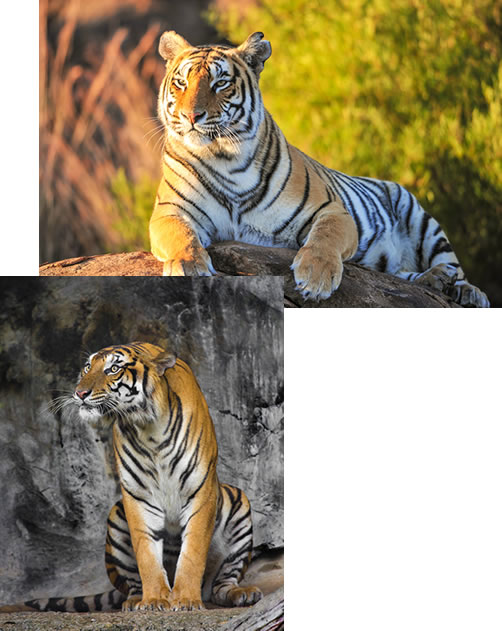 And if the zoo or marine park is faced with financial or infrastructure challenges, the animals usually bear the brunt of the fallout and suffer from neglect. Several zoos in various parts of the world have gone bankrupt and left the animals to perish due to crumbling infrastructures or food shortages. And zoos often sell older / ill animals to game ranches where trophy hunters pay to take a close-range shot in order to kill an animal (also known as a canned hunt).
And if the zoo or marine park is faced with financial or infrastructure challenges, the animals usually bear the brunt of the fallout and suffer from neglect. Several zoos in various parts of the world have gone bankrupt and left the animals to perish due to crumbling infrastructures or food shortages. And zoos often sell older / ill animals to game ranches where trophy hunters pay to take a close-range shot in order to kill an animal (also known as a canned hunt).
In recent years, campaigns have encouraged concerned citizens to boycott zoos and marine parks, and demanded larger, more natural enclosures for the animals. Due to public pressure, marine parks like SeaWorld announced plans to stop breeding orca whales. Meanwhile, many zoos across the U.S. are releasing some sick and unhappy animals like elephants to sanctuaries.
Rodeos
Ah yes, the wild West. Images of cowboys herding cattle and riding across the open range. Rodeos are an American tradition, right?
The truth is that the animals are unwilling participants in rodeos — and people subject them to what could be labeled as nothing other than abuse.
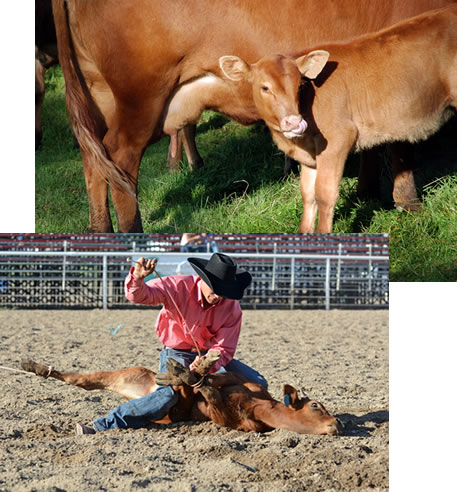 The baby cows — calves — are physically abused and frightened; many of them become seriously injured and/or die as a result of their being jerked and thrown around while running at high speeds and suffering from broken bones, internal bleeding and/or paralysis due to spinal cord injuries.
The baby cows — calves — are physically abused and frightened; many of them become seriously injured and/or die as a result of their being jerked and thrown around while running at high speeds and suffering from broken bones, internal bleeding and/or paralysis due to spinal cord injuries.
Rodeos provoke normally tame animals into behavior that is not natural to the animal — just to force the animal to appear aggressive. So do you know why bulls and horses buck? Because someone inserts an electronic rod into the animals’ backside (rectum) just before letting them out of the shoot. Due to this practice, the animals become agitated enough to buck and / or raise their front legs up into the air. Or rodeos utilize other painful techniques such as tail or neck twisting, bucking straps or spurs in order to get the animal to react.
The rodeos consider the animals expendable because they are, after all, headed to a slaughterhouse, so who cares, right?
In recent years, rodeo revenues have declined as more people become aware of the abuse and suffering of the animals and stop attending this cruel form of “entertainment.” It seems like there must be other more humane ways to honor and acknowledge American history.
Circus Captivity
Have you ever asked yourself just what it would take for a wild animal to perform unnatural tricks? Are lions, tigers, elephants, bears and other wild animals that eager to please their trainers and perform tricks for Scooby snacks and affection (similar to a domesticated dog)?
 As it turns out, it apparently takes a lot of intimidation, physical violence, abuse, dominance and fear to force wild animals into performing acts that go against their very nature — to get a wild animal who is deathly afraid of fire to willingly jump through a ring of flames. And none of this is good for the animals forced to perform in a circus.
As it turns out, it apparently takes a lot of intimidation, physical violence, abuse, dominance and fear to force wild animals into performing acts that go against their very nature — to get a wild animal who is deathly afraid of fire to willingly jump through a ring of flames. And none of this is good for the animals forced to perform in a circus.
Origin of Circuses
Did you know that in the mid 16th century in Europe, the first circuses were comprised of humans with unusual physical characteristics, known as “freak shows”? Then in the 1840s, P.T. Barnum (sound familiar?) made this form of entertainment popular in the U.S. with his museum of dwarfs, midgets, giants, obese or bearded ladies, elephant men, or otherwise “freakish” people.
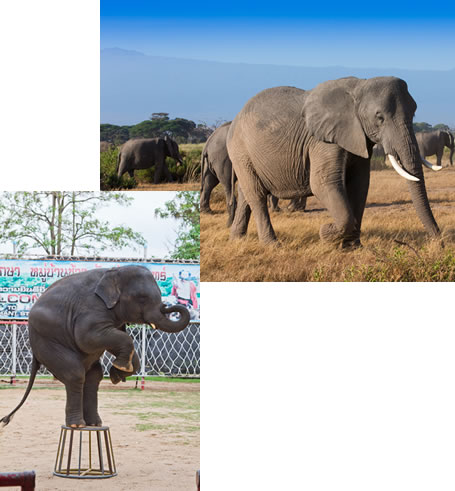 Apparently that was eventually deemed inhumane and distasteful, and freak show popularity declined by the end of the 1890s. Enter wild animals subjected to captivity and torture for human entertainment.
Apparently that was eventually deemed inhumane and distasteful, and freak show popularity declined by the end of the 1890s. Enter wild animals subjected to captivity and torture for human entertainment.
Wild Animals Held in Captivity
Just as with zoos and marine parks, hunters capture baby animals and take them away from their mothers in the wild. Then circuses train them in a number of unimaginable, abusive and painful ways in order to force them to perform circus tricks. Bears riding bikes wearing tutus, elephants standing on small barrels, and tigers jumping through rings of fire. This is all for the sake of human entertainment? Bullhooks, whips, chains, beatings, burnings, etc. Circuses use these as common training techniques for these animals and it’s all business as usual. But of course, circus management keeps this hidden from the public as much as possible.
Circuses keep the animals in cages, chained and trapped in captivity for days on end while on the road traveling between circus locations in hot cages / trucks without water or exercise. And then to thank them for their service and time, do they receive a gold watch as a retirement gift or severance package? No way; circuses often sell the animals to game ranches where trophy hunters shoot them at close range in what is called a “canned hunt.” Or perhaps circuses sell them to a research facility. Thanks a lot.
Thankfully, the tide seems to be starting to turn for the animals. Barnum & Bailey’s Circus just announced the retirement of all of its elephants from its performances worldwide. With the popularity of circuses featuring only human performers (like Cirque de Soleil), we’re slowly phasing animals out of circuses.
Animal Racing
The excitement of legal gambling –of watching your horse or dog cross the finish line first — is also steeped in history and tradition dating back to chariot races held in 650 BC Greece. Greyhound racing dates back to the 1880s, while sled dog racing dates back to the early 1900s.
 The problem is that there are just too many injuries to the animals — because the horses and dogs are subjected to abuse (and often, death) in the process. One in 22 horses suffers from an injury that prevents the horse from finishing a race. Consequently, hundreds of thoroughbreds die every year in the U.S. alone from this “sport.”
The problem is that there are just too many injuries to the animals — because the horses and dogs are subjected to abuse (and often, death) in the process. One in 22 horses suffers from an injury that prevents the horse from finishing a race. Consequently, hundreds of thoroughbreds die every year in the U.S. alone from this “sport.”
The statistics for injury, mistreatment and early deaths are even higher / worse for greyhounds involved in racing. People kill tens of thousands of animals each year using unmentionable methods when they no longer win a race. And dogs used in sled races become sick, injured, exhausted — if they even finish the race alive or without more serious injuries.
Breeders will immediately kill the animals who no longer finish as a winner, or sell them for human consumption (horses) or for lab research (dogs). Talk about the ultimate act of betrayal for these sentient beings and companion animals.
 Again, as the realities of animal racing come to light and reach public consciousness, their popularity continues to decline. Commercial dog racing is now illegal in 40 U.S. states. And Australia banned it after discovering that racing organizations had killed nearly 70,000 greyhounds in just over a decade. That number equated to 50% of all dogs bred for racing.
Again, as the realities of animal racing come to light and reach public consciousness, their popularity continues to decline. Commercial dog racing is now illegal in 40 U.S. states. And Australia banned it after discovering that racing organizations had killed nearly 70,000 greyhounds in just over a decade. That number equated to 50% of all dogs bred for racing.
Hopefully someday soon, racing will become a distant memory for the animals.
Bullfighting and Other Animal Fighting
Talk about an archaic form of human entertainment that is based on centuries of tradition. Bullfighting dates back to 2,000 BC in Spain.
What actually occurs during a bullfight could not by any stretch of the imagination truly be considered a fair fight. Management intentionally incapacitates the bulls with heavy sandbags on their backs. Or management will drug the animals beforehand in order to slow them down and make them weaker. Another common practice is to shave the animal’s horns in order to impair their coordination and throw them off balance. And then the matador gouges the animal with lances, pointed sticks, and swords to kill the bull.
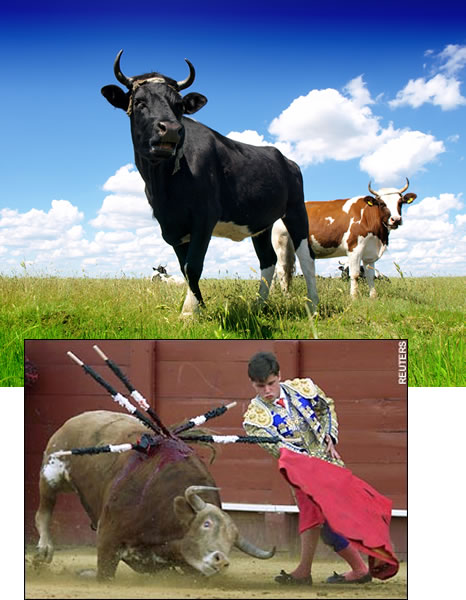 And it’s not exactly a ticket to long-term health and livelihood for the matadors either. In 2013 alone, bulls seriously injured over 30 matadors. And a bull gored a matador to death in mid-2016.
And it’s not exactly a ticket to long-term health and livelihood for the matadors either. In 2013 alone, bulls seriously injured over 30 matadors. And a bull gored a matador to death in mid-2016.
Consequently, Spanish countries such as Catalonia and Barcelona have banned bullfighting. And we expect many more countries to follow suit in the near future.
As for other forms of animal fighting, dogfighting is illegal in the U.S. except for Kentucky (believe it or not). And several other countries (with the exception of Japan, Honduras and parts of Russia) have banned dogfighting. Cockfighting is now illegal in 47 U.S. states. That’s not to say that animal fighting no longer occurs in the form of illegal rings. But hopefully humans will evolve to where they no longer consider any form of animal “fighting” acceptable let alone entertaining.
Other Animal Forms of “Entertainment”
Meanwhile, it seems on a daily basis we find another announcement where someone has abused / exploited an animal in a situation that served as some form of human entertainment.
From horse-drawn carriage rides in New York, to the decline of animal actors in Hollywood, to hundreds of petting zoos, animal rides, races, or other animal-related contests and games at county fairs and events all over the world. You name it, and someone has probably tried to make money at an animal’s expense, captivity and suffering. But with more awareness comes a better life for the animals — where we humans no longer subject them to cruelty, abuse, fear and early painful deaths in order to keep us entertained.
Gory Details / Other Articles
http://www.lcanimal.org/index.php/campaigns/animals-in-entertainment/zoos
http://www.peta.org/issues/animals-in-entertainment/animals-used-entertainment-factsheets/zoos-pitiful-prisons/
http://www.lcanimal.org/index.php/campaigns/animals-in-entertainment/marine-parks
http://www.lcanimal.org/index.php/campaigns/animals-in-entertainment/circuses
http://www.peta.org/issues/animals-in-entertainment/animals-used-entertainment-factsheets/circuses-three-rings-abuse/
http://www.lcanimal.org/index.php/campaigns/animals-in-entertainment/rodeos
http://www.peta.org/issues/animals-in-entertainment/animals-used-entertainment-factsheets/rodeo-cruelty-buck/
http://www.lcanimal.org/index.php/campaigns/animals-in-entertainment/horse-racing
http://www.lcanimal.org/index.php/campaigns/animals-in-entertainment/greyhound-racing
http://www.lcanimal.org/index.php/campaigns/animals-in-entertainment/bullfighting
http://www.peta.org/issues/animals-in-entertainment/animals-used-entertainment-factsheets/bullfighting-tradition-tragedy/
http://www.lcanimal.org/index.php/campaigns/animals-in-entertainment/dog-fighting
http://www.lcanimal.org/index.php/campaigns/animals-in-entertainment/cockfighting
http://www.lcanimal.org/index.php/campaigns/animals-in-entertainment/nyc-horse-carriages
http://www.peta.org/issues/animals-in-entertainment/animals-used-entertainment-factsheets/animal-actors-command-performances/
http://www.peta.org/issues/animals-in-entertainment/animal-games-rides-contests/
Sources for this Article
http://www.peta.org
http://lcanimal.org
http://www.wikipedia.org
http://www.history.com
http://www.grey2kusa.org/action/states.html
https://www.animallaw.info/article/chart-state-dogfighting-laws
http://abcnews.go.com/WNT/story?id=131142
http://horsefund.org/horse-racing-fact-sheet.php
http://www.npr.org/sections/thetwo-way/2015/03/05/390951839/ringling-bros-says-no-more-circus-elephants-by-2018
http://www.telegraph.co.uk/news/2016/07/09/matador-gored-to-death-in-spanish-bullfight-is-first-bullfighter/
https://www.thedodo.com/

